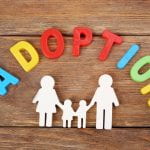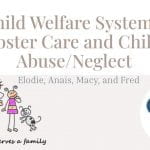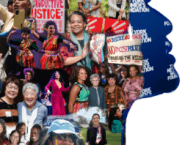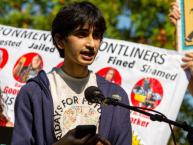
On Thursday, Feb 24, 2022, Our group: Child Welfare, Foster Care, and Adoption, interviewed April Dinwoodie (JuneinApril) about her experience in being adopted, and the issues in the foster care system today. April Dinwoodie was born to Helen June and put into temporary foster care immediately after. Helen already had 3 children and did not know if she would be able to care for another. April was adopted soon after by the Dinwoodies, who badly wanted a daughter. Her parents requested any child no matter the race, they would gladly take her in. April lived with her adopted family on a little farm in New England. She was the only biracial kid in her town. She was the only one with brown skin and thick curly hair. She spent her early days playing with her siblings outside and running around. Her difference never bothered her, that is until she had to go to school. She was treated differently, as an outsider. She would get lots of microaggressions and hurtful comments. Sometimes it was implicit, other times not. Most people didn’t notice, not even her parents. Her parents treated her the same as all her other siblings, but sometimes April felt that she wanted to be treated differently, like braiding her hair instead of trying to brush it out. Her blackness was being erased. It’s not widely understood that foster children often need different things than non-adoptive/foster children.
April began the search for her birth mother in her 20s. This was a very emotional experience because her mother did not want to be in contact with her. It felt like a double rejection. To be pushed away for a second time. April decided that she didn’t want anyone else to be as sad as she was, so she started a program. Her first program focused on getting mentors for foster children whom they could relate to. The mentors all had been involved in the foster care system as a child in some way. April also talked to us about many current problems. Yearly, there are over 400,000 in the foster care system. 25% of those children are currently waiting to be adopted, the others have the option of going back to their families. Most families only want babies, as they are easier to manage. Older children are more likely to have experienced and remembered some kind of trauma. This can be very daunting for parents. There is currently also a lack of available parents. Data strongly shows that black and brown children are involved and affected astronomically by the foster care system. Black children make up 23% out of 436,000 children in the foster care system currently. African Americans only make up 14% of the U.S. population. Black and brown children are also three times less likely to be adopted than their white counterparts.
April said that in her opinion, the biggest thing that isn’t working in the foster care system is listening. Adults do not listen to kids, especially teenagers. Professionals need to listen to the children’s needs because they are aware of their emotions. They have the right to say what they want their futures to look like. It is so common for adults to tell children and adolescents that they don’t really know what they want. The foster care also moves children around too much. This causes a lot of stress on children. When children do not feel that they are in a comfortable and stable home, it increases their feelings of rejection and low self worth. Children need to be valued more. Most foster children aren’t told that they are wanted, and that they have worth. It literally is not in the social security worker’s pay grade. Social security workers are overworked and do not get paid nearly enough. They don’t have the time, training, or energy to really commit to cases, and keep in mind the feelings of the children they are trying to help.
The foster care system is something that is really untalked about. It’s also something that is shamed. “We think we cant have more than one family.” What April is saying is that it’s considered shameful to be a foster kid. All of them are made to think that they aren’t wanted or that their parents don’t want them by society. More focus needs to be put on children’s well-being, to try and reduce and heal the trauma that affects all of them.









